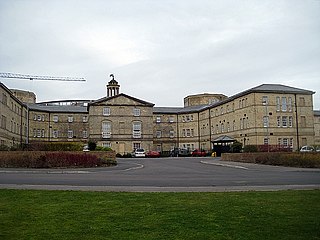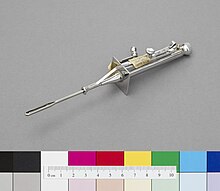Psychosurgery, also called neurosurgery for mental disorder (NMD), is the neurosurgical treatment of mental disorder. Psychosurgery has always been a controversial medical field. The modern history of psychosurgery begins in the 1880s under the Swiss psychiatrist Gottlieb Burckhardt. The first significant foray into psychosurgery in the 20th century was conducted by the Portuguese neurologist Egas Moniz who during the mid-1930s developed the operation known as leucotomy. The practice was enthusiastically taken up in the United States by the neuropsychiatrist Walter Freeman and the neurosurgeon James W. Watts who devised what became the standard prefrontal procedure and named their operative technique lobotomy, although the operation was called leucotomy in the United Kingdom. In spite of the award of the Nobel prize to Moniz in 1949, the use of psychosurgery declined during the 1950s. By the 1970s the standard Freeman-Watts type of operation was very rare, but other forms of psychosurgery, although used on a much smaller scale, survived. Some countries have abandoned psychosurgery altogether; in others, for example the US and the UK, it is only used in a few centres on small numbers of people with depression or obsessive-compulsive disorder (OCD). In some countries it is also used in the treatment of schizophrenia and other disorders.

A lobotomy or leucotomy is a form of neurosurgical treatment for psychiatric disorder or neurological disorder that involves severing connections in the brain's prefrontal cortex. The surgery causes most of the connections to and from the prefrontal cortex, the anterior part of the frontal lobes of the brain, to be severed.

Bethlem Royal Hospital, also known as St. Mary Bethlehem, Bethlehem Hospital and Bedlam, is a psychiatric hospital in Bromley, London. Its famous history has inspired several horror books, films, and TV series, most notably Bedlam, a 1946 film with Boris Karloff.

Warlingham is a village and civil parish in the Tandridge district of Surrey, England, 14 miles (23 km) south of London and 22 miles (35 km) east of Guildford. Warlingham is the centre of a civil parish that includes Hamsey Green to the north. Caterham is 2 miles (3.2 km) to the southwest.

Barnwood House Hospital was a private mental hospital in Barnwood, Gloucester, England. It was founded by the Gloucester Asylum Trust in 1860 as Barnwood House Institution and later became known as Barnwood House Hospital. The hospital catered for well-to-do patients, with reduced terms for those in financial difficulties. It was popular with the military and clergy, and once counted an archbishop amongst its patients. During the late nineteenth century Barnwood House flourished under superintendent Frederick Needham, making a healthy profit and receiving praise from the Commissioners in Lunacy. Even the sewerage system was held up as a model of good asylum practice. After the First World War service patients, including war poet and composer Ivor Gurney, were treated with a regime of psychotherapy and recreations such as cricket.

Cane Hill Hospital was a psychiatric hospital in Coulsdon in the London Borough of Croydon. The hospital motto was "Aversos compono animos". The former site is owned by GLA Land and Property.

Atkinson Morley Hospital (AMH) was located at Copse Hill near Wimbledon, South-West London, England from 1869 until 2003. Initially a convalescent hospital, it became one of the most advanced brain surgery centres in the world, and was involved in the development of the CT scanner. Following its closure, neuroscience services were relocated to the new Atkinson Morley Wing of St George's Hospital, Tooting.

A leucotome or McKenzie leucotome is a surgical instrument used for performing leucotomies and other forms of psychosurgery.
Psychosurgery is a surgical operation that destroys brain tissue in order to alleviate the symptoms of mental disorder. The lesions are usually, but not always, made in the frontal lobes. Tissue may be destroyed by cutting, burning, freezing, electric current or radiation. The first systematic attempt at psychosurgery is commonly attributed to the Swiss psychiatrist Gottlieb Burckhardt who operated on six patients in 1888. In 1889 Thomas Claye Shaw reported mental improvement in a case of General Paralysis of the Insane after a neurosurgical intervention. This led to a lively debate in the British Medical Journal on the usefulness of neurosurgery for the treatment of insanity. In the 1930s the Portuguese neurologist Egas Moniz developed a surgical technique for the treatment of mental illness and called it "leucotomy" or "psychosurgery". Moniz' technique was adapted and promoted by American neurologist Walter Freeman and his neurosurgeon colleague James W. Watts. They called their operation, where burr holes are drilled in the side of the skull and the white matter is sliced through in order to sever the connections between the frontal lobes and deeper structures in the brain, lobotomy. In the United Kingdom it became known as the standard Freeman-Watts prefrontal leucotomy. British psychiatrist William Sargant met Freeman on a visit to the United States and on his return to England encouraged doctors at the Burden Neurological Institute in Bristol to instigate a programme of psychosurgery.

South London and Maudsley NHS Foundation Trust, also known as SLaM, is an NHS foundation trust based in London, England, which specialises in mental health. It comprises four psychiatric hospitals, the Ladywell Unit based at University Hospital Lewisham, and over 100 community sites and 300 clinical teams. SLaM forms part of the institutions that make up King's Health Partners, an academic health science centre.
Psychiatry is the medical specialty devoted to the diagnosis, prevention, and treatment of deleterious mental conditions. These include various matters related to mood, behaviour, cognition, and perceptions.

The Stanley Royd Hospital, earlier named the West Riding Pauper Lunatic Asylum, was a mental health facility in Wakefield, West Yorkshire. It was managed by the Wakefield and Pontefract Community Health NHS Trust.

The lunatic asylum or insane asylum was an early precursor of the modern psychiatric hospital.

Tone Vale Hospital was a psychiatric hospital located approximately 3 kilometres (1.9 mi) to the north west of Norton Fitzwarren, near Taunton, Somerset, England, in what is now the village of Cotford St Luke. It covered a large catchment area, with patients originating from places as far apart as Porlock and Yeovil.
Sir Wylie McKissock, OBE was a British neurosurgeon. He set up the neurosurgical unit at the Atkinson Morley Hospital, was Britain's most prolific leucotomist (lobotomist), and president of the Society of British Neurological Surgeons.
Psychosurgery, also called neurosurgery for mental disorder or functional neurosurgery, is surgery in which brain tissue is destroyed with the aim of alleviating the symptoms of mental disorder. It was first used in modern times by Gottlieb Burckhardt in 1891, but only in a few isolated instances, not becoming more widely used until the 1930s following the work of Portuguese neurologist António Egas Moniz. The 1940s was the decade when psychosurgery was most popular, largely due to the efforts of American neurologist Walter Freeman; its use has been declining since then. Freeman's particular form of psychosurgery, the lobotomy, was last used in the 1970s, but other forms of psychosurgery, such as the cingulotomy and capsulotomy have survived.
Healthcare in London, which consumes about a fifth of the NHS budget in England, is in many respects distinct from that in the rest of the United Kingdom, or England.

Bethlem Museum of the Mind is a museum focusing on the history of Bethlem Royal Hospital, its programme of care, and its patients. Opened in 2015, the museum is housed in an Art Deco building shared with the Bethlem Gallery, which hosts exhibitions of contemporary artists who are current or former patients.

Prestwich Hospital was a mental health facility in Prestwich, Greater Manchester, England.















